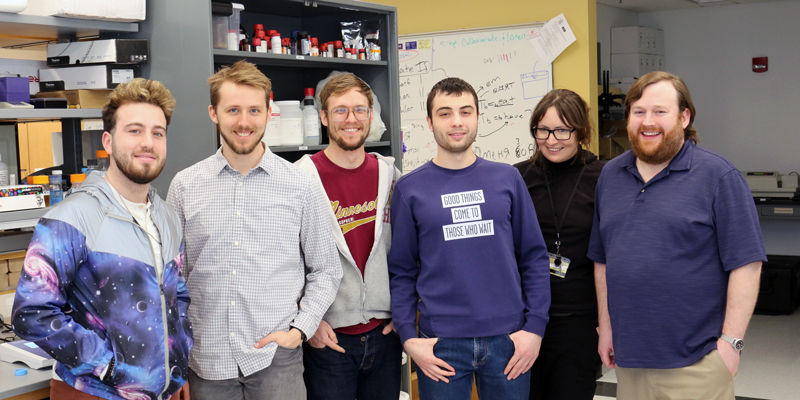Kate Adamala and Aaron Engelhart join NASA-based team with aim to better understand the impact of space travel on RNA folding and synthetic cell function.

Aaron Engelhart (furthest right) and Kate Adamala (second right) with a few of the graduate students in their labs helping launch the NASA project.
Humans look to the stars and see infinite opportunities of travel and exploration. But when we launch ourselves out of Earth’s atmosphere, what impact do we make on our own bodies and potentially the other planets we reach? CBS faculty Aaron Engelhart and Kate Adamala aim to find out.
The two recently joined a project led by NASA interns who will launch a small rocket into low-Earth orbit this summer to run a number of experiments in zero gravity. The team hopes to better understand what impact low gravity has on cellular function.
“These are exciting questions,” says Engelhart. “We’re at a stage where the technologies have come to the right place at the right time where things like fluorescent RNA can be used to evaluate some of these processes.”
For Engelhart, he aims to further understand how a lack of gravity impacts how well RNA can fold. By using RNA that becomes fluorescent when it folds appropriately, he hopes this will have a broader look into what happens to our cells when we head into space.
“We know that there are changes that happen to astronauts during space flight, but we don’t know exactly what that entails,” says Engelhart. “This experiment is designed to use some simple technology that allows us to ask this question using fluorescence technology and that lends itself well to miniaturization.”
While Engelhart aims to better understand the RNA folding process, Adamala plans to also use fluorescent technology to see how well protein expression works in synthetic cells for potential use in space adaptation issues.
“Synthetic cells can be designed so you put specific kill switches in them so they don’t just go out of control and start replicating,” says Adamala. “People have had the idea of running synthetic cells in space ideas for a long time, but it’s never been done before, so we don’t know if those ideas are good at all.”
If all goes to plan, the team’s initial experiment will launch this June from Virginia. The initial experiment will take place in a smaller rocket which will go into low gravity for about 10 minutes, and then come back to Earth. If their insights lead to intriguing answers, the team has the potential to launch similar experiments on a longer run.
“The idea is that if we can do a 10 minute experiment, we can show that the system we created and the biological system we’re sending up can generate the data, and then you can do a longer run,” says Engelhart. “If things go well, we may be able to run similar experiments in a cube satellite for more extensive research.”
--Lance Janssen